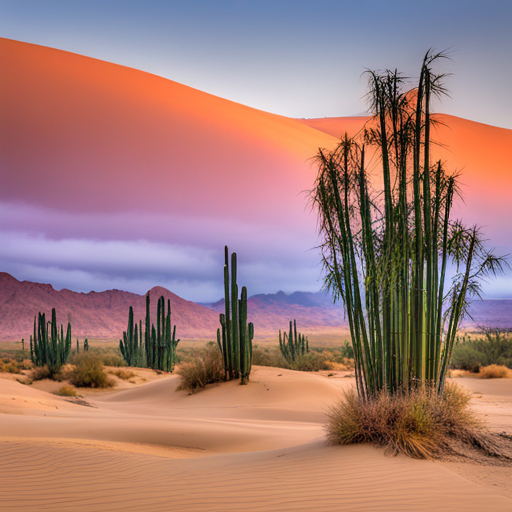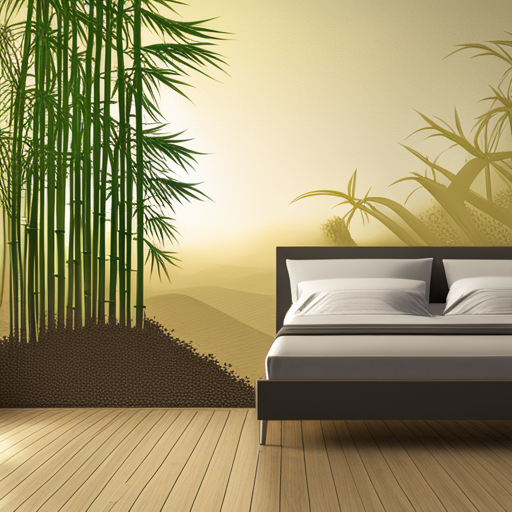Bamboo, a versatile and fast-growing plant, has the potential to thrive in desert conditions with careful selection of the appropriate species and proper care. This article aims to provide valuable insights into growing bamboo in the desert, focusing on selecting the right species and offering essential care tips.
The choice of bamboo species is crucial, with clumping varieties recommended for their deeper roots and better water access, while runners exhibit higher tolerance for dry, hot air. Watering plays a vital role in the success of desert bamboo, and regular watering, especially during the initial years, is essential. Bamboo retains moisture better than typical lawn grass, and watering every other day with light watering is usually sufficient. Additional measures such as watering in the morning or evening and applying mulch can help reduce evaporation.
Furthermore, this article will delve into maintenance and privacy considerations, as well as the importance of selecting cold-hardy species for Zone 4. By following these guidelines, individuals can successfully cultivate bamboo in desert environments.
Contents
- 1 Our Highlighted Points
- 2 Choosing the Species
- 3 Watering and Care
- 4 Maintenance and Privacy
- 5 Frequently Asked Questions
- 5.1 Can bamboo survive in extreme desert environments with little to no water?
- 5.2 How long does it typically take for bamboo to recover from transplant shock?
- 5.3 Are there any specific diseases or pests that commonly affect bamboo in the desert?
- 5.4 Can bamboo be planted near pools or other water features?
- 5.5 Is it possible to grow bamboo indoors in the desert?
Our Highlighted Points
- Choosing the right species of bamboo is crucial for growing in dry climates.
- Regular watering, especially in the first few years, is essential for bamboo in the desert.
- Bamboo retains moisture better than typical lawn grass, but extra mulch can help slow evaporation in extreme desert environments.
– Clumping bamboo species root deeper and have more water access, while runners have higher tolerance for dry, hot air.
Choosing the Species

When it comes to growing bamboo in the desert, selecting the appropriate species is crucial for ensuring successful cultivation. The arid climate and extreme temperatures of desert regions pose unique challenges for bamboo growth. To overcome these obstacles, it is important to choose desert-friendly bamboo species that can thrive in dry conditions.
Some tips for choosing the right bamboo species for the desert include considering their water requirements, bamboo tolerance to heat and drought, and ability to withstand the harsh desert environment. Certain species, such as Phyllostachys nigra ‘Henon, Semiarundinaria fastuosa, and Phyllostachys aurea Golden Bamboo, have been found to be well-suited for desert conditions.
By carefully selecting the appropriate bamboo species, gardeners can ensure successful growth and cultivation in the desert.
Watering and Care

Regular watering and proper care are essential for the successful growth of bamboo in arid environments. To ensure the health and vitality of bamboo in the desert, attention must be given to watering frequency and mulching techniques. Here are some tips to help you care for your desert-grown bamboo:
- Watering frequency:
- Water regularly for the first few years after planting to establish a strong root system.
- Water every other day with light watering to provide sufficient moisture.
- Watering in the morning or evening helps minimize evaporation.
- Mulching techniques:
- Add extra mulch around the base of the bamboo to slow down evaporation in extreme desert environments.
- Mulch also helps to retain moisture and regulate soil temperature.
- Use organic mulch materials such as wood chips or straw to improve soil fertility.
By following these watering and mulching techniques, you can ensure the well-being of your desert bamboo and promote its healthy growth in arid conditions.
Maintenance and Privacy

Maintenance and privacy are important considerations when cultivating bamboo in arid environments. To ensure the health and longevity of your bamboo, regular maintenance is necessary. This includes watering the plants every other day with light watering, preferably in the morning or evening to minimize evaporation. Adding extra mulch can help slow down evaporation in extreme desert conditions.
Additionally, pruning is crucial to maintain the desired shape and height of the bamboo. Non-invasive clumping bamboo species are ideal for maintenance as they do not spread aggressively.
When it comes to privacy, choosing the right bamboo species is essential. Bamboo varieties such as Phyllostachys aurea Golden Bamboo, Bambusa oldhamii, and Alphonse Karr are known for their dense growth and can create a private oasis in your garden.
Proper maintenance and careful selection of bamboo species will ensure a thriving and private bamboo landscape in the desert.
You may also like reading tips for growing transplant bamboo with care.
Frequently Asked Questions
Can bamboo survive in extreme desert environments with little to no water?
Drought tolerant bamboo species suitable for desert climates include Phyllostachys nigra ‘Henon, Semiarundinaria fastuosa, Phyllostachys aurea Golden Bamboo, Phyllostachys glauca ‘Yunzhu, Bambusa oldhamii, Alphonse Karr, Phyllostachys mannii ‘Decora, and Otatea acuminata. Techniques for conserving water while growing bamboo in the desert include regular watering for the first few years, watering every other day with light watering, watering in the morning or evening to minimize evaporation, and adding extra mulch to slow evaporation in extreme desert environments.
How long does it typically take for bamboo to recover from transplant shock?
The recovery time for bamboo after transplant shock varies, but it typically takes several weeks to a few months. To reduce transplant shock, it is important to provide well-watering and allow sufficient time for the bamboo to recover and establish new roots.
Are there any specific diseases or pests that commonly affect bamboo in the desert?
Common bamboo diseases in the desert include root rot, rust, and leaf spot. Effective pest control for bamboo involves regular inspection and early detection of pests such as aphids, spider mites, and bamboo mites, followed by appropriate treatment methods.
Can bamboo be planted near pools or other water features?
Bamboo can be planted near pools or other water features, as it can serve as a landscaping option for water conservation. However, it is important to consider bamboo’s growth habits and maintenance requirements for pool upkeep.
Is it possible to grow bamboo indoors in the desert?
Successfully cultivating bamboo in arid indoor environments in the desert poses challenges. Lack of natural sunlight, low humidity, and limited space are obstacles. Solutions include providing artificial lighting, maintaining proper humidity levels, and selecting indoor bamboo species adaptable to arid conditions.

